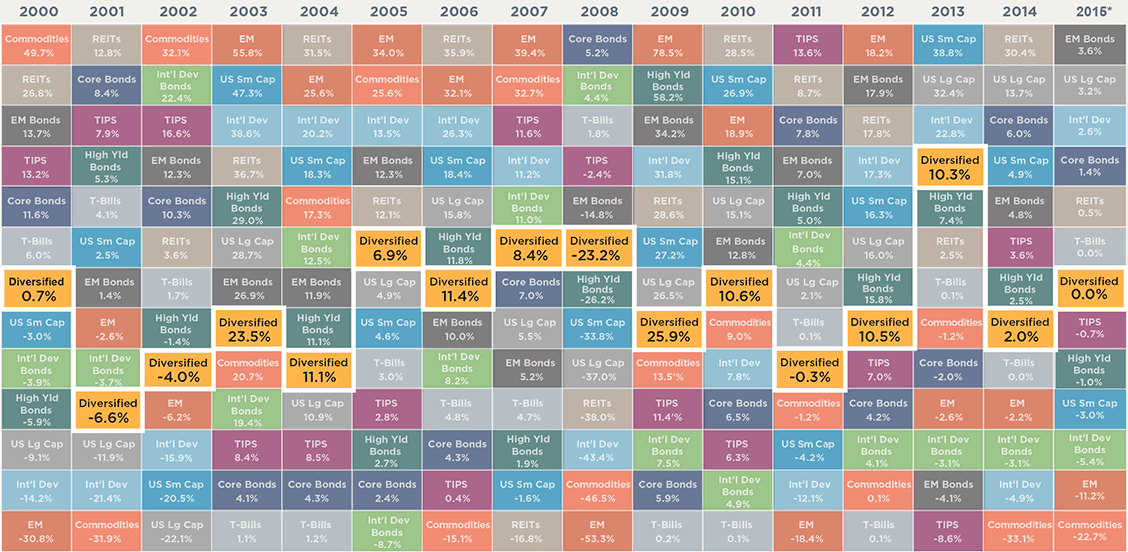Is Your Portfolio Really Diversified?
Your investments should be spread across a variety of stocks and bonds and cover a range of asset managers, asset classes and geographical locations.

Diversification is simple to understand. In the context of managing your portfolio, it is (simply) about investing in diverse securities so as to lower the risk of the portfolio. Ever since Nobel Prize winner Harry Markowitz wrote his seminal paper "Portfolio Selection" in 1952, finance professionals (and increasingly lay people) have understood that the true risk of an asset is its contribution to the risk of a portfolio.
In a recent survey run by my firm, Insight Financial Strategists, 41% of investors reported that they believe having their net worth in a single mutual fund is sufficient diversification. After all, even the most concentrated mutual fund typically has several dozen stocks. However, many mutual funds diversify within a single asset class in a single country, such as, large-company stocks in the U.S.
Others will concentrate their portfolio on a few securities, sometimes with very unfortunate results. For instance, between September 1, 2015, until November 17, 2015, the Sequoia fund (symbol SEQUX) lost 26.3% of its value largely due to its high concentration in a single stock, Valeant (VRX). Looking at the price evolution of VRX below, and knowing that SEQUX had more than 30% invested in VRX, it is not surprising that the mutual fund tumbled.
From just $107.88 $24.99 for Kiplinger Personal Finance
Become a smarter, better informed investor. Subscribe from just $107.88 $24.99, plus get up to 4 Special Issues

Sign up for Kiplinger’s Free Newsletters
Profit and prosper with the best of expert advice on investing, taxes, retirement, personal finance and more - straight to your e-mail.
Profit and prosper with the best of expert advice - straight to your e-mail.

In practice, diversification is hard to implement. There are many levels of diversification. Some of them are:
- by individual securities;
- by asset manager;
- by asset class; and
- by geography.
Ideally, an investor will want to diversify so that the various investments are not correlated with one another, have low correlation or even have negative correlation. For instance, according to data from portfolio analytics firm Kwanti, Goldman Sachs (GS) and JP Morgan (JPM) have an 89% correlation based on monthly returns. In other words, buying GS and JPM in the same portfolio only provides a low diversification value.
In another example, JPM and Walmart (WMT) have a negative correlation of -0.14%, based on monthly returns, according to data from Kwanti. I don't know that I would necessarily want to buy either JPM or WMT. However, this pair provides good diversification from one another.
Most of us end up investing in mutual funds and exchange-traded funds, not in individual securities. The same principle applies there. Having a single large cap mutual fund that tracks Standard & Poor's 500-stock index may not be sufficient diversification.
Sure, the S&P 500 ETF provides more than one security and is, therefore, diversified. But in general, most of the securities within a single asset class will be highly correlated with one another (such as with JPM and GS). With that, you would be protecting yourself against the risk inherent in any given company in the portfolio, but not against risks inherent to the asset class or other factors.
Ideally, you would want to be diversified across asset classes, across regions of the world and across asset managers. The following jelly bean chart from Schwab demonstrates the benefits of a wide diversification program: the ranking of the assets by performance changes seemingly randomly from year to year. A fully diversified portfolio is intended to avoid the peaks and valleys of individuals asset classes while providing a more middle-of-the-road return experience.

Is your portfolio diversified? A detailed analysis from a fee-only Certified Financial Planner can give you the full scoop on your portfolio and provide suggestions to mitigate the risks that you are exposed to. Like any other sound advice, apply it now, not later.
Chris Chen CFP® CDFA is the founder of Insight Financial Strategists LLC, a fee-only investment advisory firm in Waltham, MA. He specializes in retirement planning and divorce financial planning for professionals and business owners.
Profit and prosper with the best of Kiplinger's advice on investing, taxes, retirement, personal finance and much more. Delivered daily. Enter your email in the box and click Sign Me Up.

Chris Chen CFP® CDFA is the founder of Insight Financial Strategists LLC, a fee-only investment advisory firm in Newton, Mass. He specializes in retirement planning and divorce financial planning for professionals and business owners. Chris is a member of the National Association of Personal Financial Advisors (NAPFA). He is on the Board of Directors of the Massachusetts Council on Family Mediation.
-
 Stocks Keep Climbing as Fed Meeting Nears: Stock Market Today
Stocks Keep Climbing as Fed Meeting Nears: Stock Market TodayA stale inflation report and improving consumer sentiment did little to shift expectations for a rate cut next week.
-
 Your End of Year Insurance Coverage Review Checklist
Your End of Year Insurance Coverage Review ChecklistStop paying for insurance you don't need and close coverage gaps you didn't know about with this year-end insurance review.
-
 Crypto Trends to Watch in 2026
Crypto Trends to Watch in 2026Cryptocurrency is still less than 20 years old, but it remains a fast-moving (and also maturing) market. Here are the crypto trends to watch for in 2026.
-
 Time Is Running Out to Make the Best Moves to Save on Your 2025 Taxes
Time Is Running Out to Make the Best Moves to Save on Your 2025 TaxesDon't wait until January — investors, including those with a high net worth, can snag big tax savings for 2025 (and 2026) with these strategies.
-
 4 Smart Ways Retirees Can Give More to Charity, From a Financial Adviser
4 Smart Ways Retirees Can Give More to Charity, From a Financial AdviserFor retirees, tax efficiency and charitable giving should go hand in hand. After all, why not maximize your gifts and minimize the amount that goes to the IRS?
-
 I'm an Insurance Pro: If You Do One Boring Task Before the End of the Year, Make It This One (It Could Save You Thousands)
I'm an Insurance Pro: If You Do One Boring Task Before the End of the Year, Make It This One (It Could Save You Thousands)Who wants to check insurance policies when there's fun to be had? Still, making sure everything is up to date (coverage and deductibles) can save you a ton.
-
 3 Year-End Tax Strategies for Retirees With $2 Million to $10 Million
3 Year-End Tax Strategies for Retirees With $2 Million to $10 MillionTo avoid the OBBB messing up your whole tax strategy, get your Roth conversions and charitable bunching done by year's end.
-
 'Politics' Is a Dirty Word for Some Financial Advisers: 3 Reasons This Financial Planner Vehemently Disagrees
'Politics' Is a Dirty Word for Some Financial Advisers: 3 Reasons This Financial Planner Vehemently DisagreesYour financial plan should be aligned with your values and your politics. If your adviser refuses to talk about them, it's time to go elsewhere.
-
 For a Move Abroad, Choosing a Fiduciary Financial Planner Who Sees Both Sides of the Border Is Critical
For a Move Abroad, Choosing a Fiduciary Financial Planner Who Sees Both Sides of the Border Is CriticalWorking with a cross-border financial planner is essential to integrate tax, estate and visa considerations and avoid costly, unexpected liabilities.
-
 I'm a Financial Adviser: This Tax Trap Costs High Earners Thousands Each Year
I'm a Financial Adviser: This Tax Trap Costs High Earners Thousands Each YearMutual funds in taxable accounts can quietly erode your returns. More efficient tools, such as ETFs and direct indexing, can help improve after-tax returns.
-
 A Financial Adviser's Guide to Divorce Finalization: Tying Up the Loose Ends
A Financial Adviser's Guide to Divorce Finalization: Tying Up the Loose EndsAfter signing the divorce agreement, you'll need to tackle the administrative work that will allow you to start over.